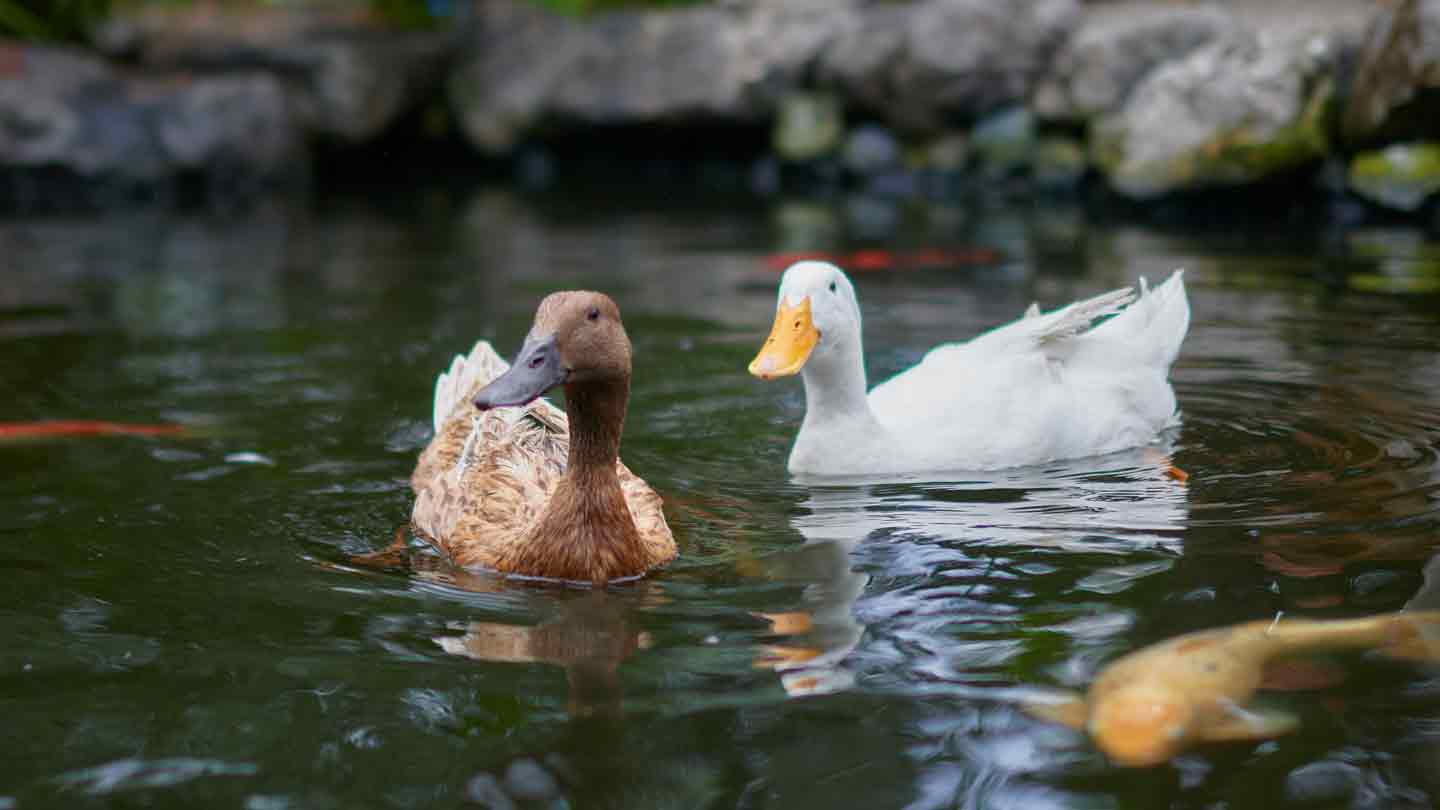In This Guide:
Choosing a Location
Whether you’re building a koi pond or a pond for ducks, location matters. Consider practical details such as accessibility and visibility, as well as factors that could affect the construction and maintenance of your pond.
Ed Beaulieu (The Pond Professor), a certified aquascape contractor at Aquascape®, Inc., in St. Charles, Illinois, says, “There are a few things that I take into consideration when choosing the proper site. The first one is visibility from the home and main viewing areas.” You want to enjoy the sight of your pond as much as possible, of course!
After assessing the aesthetics of a pond location, determine its practical viability. Consider construction challenges, such as access for equipment and soil type for digging. Observe how much sunlight the space gets as well—partial shade is ideal for minimizing algae growth.
“Pick a site that is not consistently wet,” adds Tim Wood, an aquascape contractor and the owner of Aquatic Edge Pond & Landscape Solutions in Pittsburgh, Pennsylvania. “Contrary to what many would think,” he says, “that can create problems.”
For example, groundwater can exert pressure on the pond liner from below, causing it to bubble. Runoff could also be an issue for ponds placed in drainage areas—a heavy rainstorm could overflow the pond or impact water quality.
Be aware that there may be legal regulations on pond building in your area as well. Some municipalities require permits to construct a pond and may place restrictions on details, such as pond size and distance from property lines. It’s also important to verify that no plumbing or underground electrical utility lines are present in the space you plan to excavate by calling 811, the national Dig Alert hotline.
Necessary Pond Equipment
To simplify the pond-building process, experts often recommend purchasing an all-inclusive pond kit from a home and garden store or pond supply retailer. Should you choose to purchase your supplies separately, here’s a quick list of what you may need.
- Pond skimmer
- Pond filter system
- Landscaping underlayment
- Pond liner
- Smooth gravel (1-inch diameter)
- Assorted rocks
- Pond lighting
- Landscaping plants
- Pond plants
- Pond water conditioner
- Bacteria additive
- Submersible pump
- Pond heater or de-icer
In addition to these backyard pond necessities, you’ll need supplies to mark out and excavate the area.
How To Build a Duck Pond: Step by Step

1Mark Out the Area
If you’re using a preformed pond liner, place it in the desired area and outline the shape using marking paint. If you’re using a flexible liner, plan out the size and shape of your pond using a garden hose or heavy rope before outlining it in marking paint.
Plan to dig two tiers—a shallow tier for ducks’ easy entry and exit from the pond, as well as a deeper space for swimming. You can mark these now or dig out the first tier before marking the second.
2Decide the Placement of Pond Equipment
Gather the pond equipment you’re using, unbox it, and decide where you’re going to place it. If you’re using a pond skimmer as well as a waterfall or pond filter, it’s best to place these elements at opposite ends of the pond. Lay out the tubing and connect it to the equipment as directed in the manufacturer’s instructions.
3Dig Out the Pond
If you’ve already marked out the two tiers of your pond, excavate the bottom tier to the desired depth. A minimum depth of 18 inches is appropriate for most domestic waterfowl like mallards and Indian runner ducks. Dig out the shallow tier to a depth of 6–8 inches. Alternatively, excavate the entire pond area to a depth of 6–8 inches then mark and dig out the deeper tier.
If you’re installing a pond skimmer or waterfall, dig out the necessary spaces for them, too, referring to the manufacturer’s instructions. You may need to install the skimmer before putting the pond liner in place. Level the tiers as much as possible and tamp down the soil.
4Install the Underlayment and Pond Liner
Roll the underlayment out over the pond area and press it into the curves of the excavated area. Work from the inside out, leaving the material slightly loose so it has room to settle. If using a flexible liner, roll it out and follow the same process.
If using a preformed pond liner, install the underlayment before putting it in place. Double-check the fit and then backfill with dirt beneath the underlayment as needed to secure it.
5Set Up Your Pond Equipment
Follow the manufacturer’s instructions to install your pond skimmer, if you’re using one. You’ll need to affix the pond liner to the faceplate of the skimmer to create a watertight seal. If you’re using a waterfall-style filter, install the filter box and attach the pond liner as per the manufacturer’s instructions.
Most other pond equipment can be added after construction is complete, but check the instructions for each just in case. Submersible pumps and powerheads improve aeration and direct water flow. If you plan to stock your pond with goldfish or other pond fish, a biological filter can help support a healthy aquatic environment. In cooler climates, a pond heater or de-icer might be needed.
6Anchor the Liner With Rocks and Gravel
Fill the bottom of the pond with about two inches of smooth 1-inch gravel to anchor the underlayment and pond liner. Place larger rocks along the shallow tier of the pond to keep the liner in place. Consider adding smaller stones in some areas to create ramp-like sections so ducklings can easily access the deeper duck pool.
7Add Lighting and Other Decor
Place large stones on the ground around the exterior edge of the pond, using rocks of varying size to create a natural pond aesthetic. Place the desired pond lighting as you go, leaving about 12 inches of the power cord wrapped around each light so you can pull it free for maintenance.
Consider placing terrestrial plants among the rocks and aquatic plants in the pond. Water lilies should be planted in the deeper section with the rhizomes (horizontal underground stems) nestled into the gravel but not completely buried. Semi-aquatic plants that grow above the water’s surface are best planted along the shallow tier.
8Fill the Pond and Treat the Water
Using a garden hose, fill the pond with fresh water and add the appropriate dose of water conditioner to neutralize chlorine and heavy metals. (Follow the instructions on your water conditioner to determine how much to use.) You might also use a beneficial bacteria additive to jump-start the biological process that helps maintain a healthy pond ecosystem.
9Complete the Finishing Touches
With your pond filled and decorated, all that’s left is to trim the pond liner and plug in your equipment. Leave an extra 6–8 inches of liner around the rocks bordering your pond and roll it under itself. Add gravel or small stones to secure it in place and create a natural-looking finish to the edge of your pond.
Maintaining Your Pond
To keep your pond water clean throughout the year, skim fallen leaves and debris (like duck poop) from the surface of the pond as needed. If you have a filtration system or other equipment installed in your pond, follow the manufacturer’s instructions for cleaning and maintenance.
Some DIY duck pond hobbyists perform more thorough cleanings on a seasonal basis, while others prefer to do so annually. To deep-clean your pond, Wood says, first you’ll need to drain it using a submersible pump to siphon the water out, directing it away from the pond area to prevent flooding or erosion. Next, Wood says, “Remove any fish, wash the liner and rocks, and use a pump or shop vac to remove accumulated muck and debris.”
You may also need to top up your new pond with clean water from time to time. If your pond is stocked with fish, be sure to use a water conditioner to remove potentially harmful chemicals and heavy metals from your tap water when performing a water change.
FAQs About Ponds for Ducks
Q:How much time does it take to build a duck pond?
A:It depends on the size and scale of the pond. “Smaller ponds and waterfalls can easily be built on a weekend if you’re a handy person who’s comfortable with physical labor,” says Beaulieu. Larger ponds may take weeks or months to complete.
Q:How much does it cost to build a duck pond?
A:Pond costs vary depending on the size of the pond and how it’s constructed. You could spend as little as $100 on a preformed small pond—even a plastic kiddie pool could suffice—or as much as $6,500 on an all-inclusive kit for a medium to large pond with filtration equipment and water features.
Q:What is the ideal size for a backyard duck pond?
A:It depends on the type and number of ducks. A small pond may be appropriate for species that primarily use water for bathing. A pond for ducks who enjoy swimming should ideally be 10 to 12 feet wide with shallow areas for easy entry and exit.
Expert input was provided by Tim Wood, an Aquascape® contractor and owner of Aquatic Edge Pond & Landscape Solutions, in Pittsburgh, Pennsylvania; and Ed Beaulieu, The Pond Professor, a certified Aquascape® contractor in St. Charles, Illinois.
Share:












